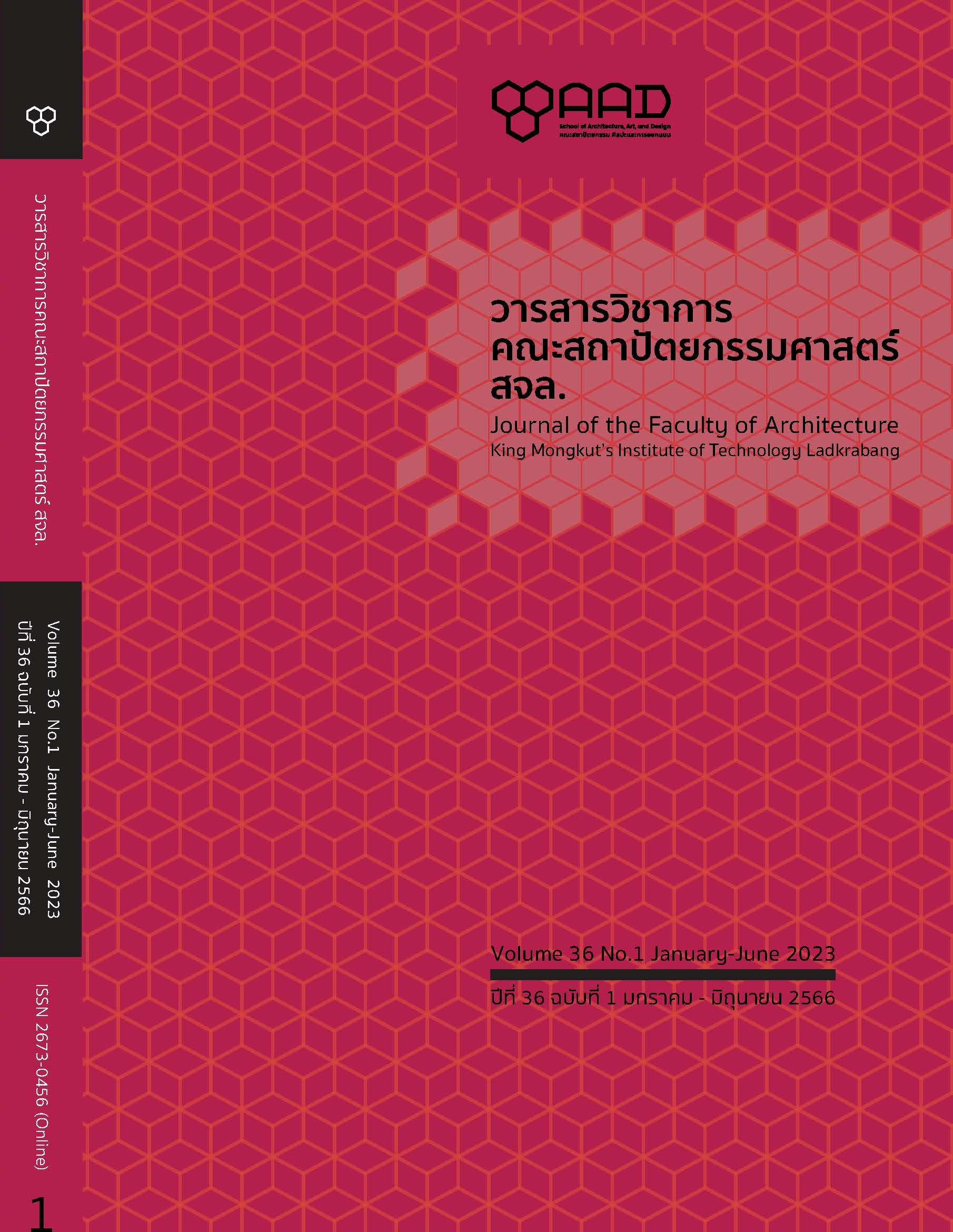Vernacular Landscape of Agricultural Communities: A case study in Mueang Khong Basin, Chiang Dao District, Chiang Mai
Main Article Content
Abstract
This research article aims to study the vernacular landscape of the agricultural communities in the Mong Khong Basin. The objectives were 1) to study the land use patterns at the settlement level, 2) to study the land use patterns at the layout level around the case houses, and 3) to study and analyze land use patterns with vernacular landscape and cultural ecology of ethnic groups settle in the study area. This work was field research using the ecological and landscape survey and the unstructured interview as a tool for data collection. The sample group was four agricultural communities, eight case houses, and twenty key informants. The researcher uses physical data analysis and data from interviews, presenting data through description, map, and figure. The results showed that the vernacular landscape of the agricultural communities was related to the settlement on the river delta and the foothill slope. The land use patterns at the layout level include residential areas, agricultural areas, and the surrounding environment. Moreover, the land use patterns at the layout level around the case houses include the house layout, the area around the house, and landscape elements. This area is the settlement of the Tai Yuan ethnic group, which inherited local wisdom in water management for agriculture in the lowlands, and the Pga Knyaw ethnic group, which inherited local wisdom in utilizing natural resources for agriculture in the highlands. The natural and cultural environmental conditions affect the common and characteristics of the land use patterns that form the vernacular landscape of the agricultural communities in the study area.
Article Details

This work is licensed under a Creative Commons Attribution-NonCommercial-NoDerivatives 4.0 International License.
This work is licensed under a Creative Commons Attribution-NonCommercial-ShareAlike 4.0 International License.
Copyright Transfer Statement
The copyright of this article is transferred to Journal of The Faculty of Architecture King Mongkut's Institute of Technology Ladkrabang with effect if and when the article is accepted for publication. The copyright transfer covers the exclusive right to reproduce and distribute the article, including reprints, translations, photographic reproductions, electronic form (offline, online) or any other reproductions of similar nature.
The author warrants that this contribution is original and that he/she has full power to make this grant. The author signs for and accepts responsibility for releasing this material on behalf of any and all co-authors.
References
เกรียงไกร เกิดศิริ .(2557). องค์รวมภูมิทัศน์วัฒนธรรมชุมชนและสถาปัตยกรรมพื้นถิ่นเรือนที่อยู่อาศัยในลุ่มน้ำทะเลสาบสงขลา. วารสารหน้าจั่ว ว่าด้วยประวัติศาสตร์สถาปัตยกรรมและสถาปัตยกรรมไทย, 11(2014), 177-213.
เกรียงไกร เกิดศิริ, นันทวรรณ ม่วงใหญ่ และสุพจน์ จิตสุทธิญาณ. (2555). ศักยภาพและแนวทางการจัดการแหล่งมรดกทางวัฒนธรรมและภูมิทัศน์วัฒนธรรมในภาคเหนือ เพื่อเสนอขอรับการจารึกชื่อเป็นมรดกโลก. วารสารหน้าจั่วการบริหารจัดการ และการอนุรักษ์สถาปัตยกรรม, 27(2013), 169-202.
ธันยา พรหมบุรมย์. (2564). รายงานฉบับสมบูรณ์การทดลองจัดโปรแกรมเส้นทางท่องเที่ยว ตำบลเมืองคอง อำเภอเชียงดาว จังหวัดเชียงใหม่. เชียงใหม่: มหาวิทยาลัยเชียงใหม่.
นวณัฐ โอศิริ. (2545). ภูมิทัศน์พื้นถิ่น ภูมิปัญญาเพื่อการประหยัดพลังงานและการพัฒนาอย่างยั่งยืน กรณีศึกษา หมู่บ้านตาลเหนือ อำเภอฮอด จังหวัดเชียงใหม่. หนังสือประมวลผลการประชุมทางวิชาการสาระศาสตร์, 6(2545), 129-144.
บงกชกร ชอบธรรม และชูศักดิ์ วิทยาภัค. (2563). “ชุมชนเมืองแกนพัฒนา” ภาพตัวแทนของการปะทะประสานระหว่างภูมิทัศน์การเกษตรและภูมิทัศน์การท่องเที่ยวในบริบทของสังคมชนบทสมัยใหม่. วารสารศรีนครินทรวิโรฒวิจัยและพัฒนา (สาขามนุษยศาสตร์และสังคมศาสตร์), 12(24), 38-49.
ภัคเกษม ธงชัย และดนัย ทายตะคุ. (2564). การเปลี่ยนแปลงของภูมิทัศน์พลวัตน้ำหลากในลุ่มแม่น้ำยม กรณีศึกษา ชุมชนบ้านกง อำเภอกงไกรลาศ จังหวัดสุโขทัย. วารสารวิชาการสาระศาสตร์ คณะสถาปัตยกรรมศาสตร์ จุฬาลงกรณ์มหาวิทยาลัย, 2(2021), 341-357.
ยศ สันตสมบัติ และคณะ. (2547). นิเวศวิทยาชาติพันธุ์ ทรัพยากรชีวภาพ และสิทธิชุมชน. เชียงใหม่: บริษัท วิทอินดีไซน์ จำกัด.
วันดี พินิจวรสิน. (2559). การส่งเสริมคุณค่าท้องถิ่นและความเข้มแข็งของชุมชนผ่านการปรับปรุงภูมิทัศน์ชุมชน. วารสารการจัดการสิ่งแวดล้อม, 12(2), 64-81.
วิวัฒน์ เตมียพันธ์. (2557). สภาพแวดล้อมทางกายภาพของแหล่งพำนักอาศัยและเรือนล้านนา สิ่งที่บ่งชี้ทางภูมิปัญญาในอดีตของไทย-ยวน. รวบรวมบทความทางวิชาการเกี่ยวกับคติความเชื่อบางประการในงานสถาปัตยกรรมไทย. กรุงเทพฯ: คณะสถาปัตยกรรมศาสตร์ สถาบันพระจอมเกล้าเจ้าคุณทหารลาดกระบัง
ศนิ ลิ้มทองสกุล. (2549). ภูมิทัศน์พื้นถิ่นของหมู่บ้านชนบทในชุมชนชาวมุสลิมในประเทศไทยและประเทศมาเลเซีย. วารสารวิจัยและสาระสถาปัตยกรรม / การผังเมือง, 4(2), 141-154.
อรศิริ ปาณินท์, สมคิด จิระทัศนกุล, ดวงเงิน พูนผล, อวิรุทธิ์ เจริญทรัพย์, พินัย สิริเกียรติกุล, ชัยสิทธิ์ ด่านกิตติกุล, ... วุฒิพงษ์ ทวีวงศ์. (2551). เรือนพื้นถิ่นไทย-ไท. กรุงเทพฯ: คณะสถาปัตยกรรมศาสตร์ มหาวิทยาลัยศิลปากร.
อัมพิกา อำลอย, ศุภกุล เรืองวิทยานุสรณ์, วรงค์ วงศ์ลังกา, แผ่นดิน อุนจะนำ, อรัญญา ศิริผล และ ระวิวรรณ โอฬารรัตน์มณี. (2565). การศึกษาภูมิทัศน์พื้นถิ่นล้านนาในบริบทชุมชนของนักวิชาการไทยในประเทศไทย ช่วง พ.ศ. 2545 – 2564. วารสารวิชาการภูมิสถาปัตยกรรม. 4(1), 62-81.
อําภา บัวระภา. (2562). รูปแบบและปัจจัยการคงอยู่ของภูมิทัศน์พิื้นถิ่น “บ้านเรือนและที่อยู่อาศัย” แขวงคําม่วนสาธารณรัฐประชาธิปไตยประชาชนลาว. วารสารสถาปัตยกรรมศาสตร์ ผังเมืองและนฤมิตศิลป์ มหาวิทยาลัยมหาสารคาม, 1(1), 10-22.
Meinig, D.W. (1979). The Beholding Eye: Ten Versions of the Same Scene. The Interpretation of Ordinary Landscapes: Geographical Essays. (pp. 33-48). New York: Oxford.
Meinig, D.W. and Jackson, J.B. (1979). Introduction. The Interpretation of Ordinary Landscapes: Geographical Essays. (pp. 1-7). New York: Oxford.
Taylor, K. (2017). Cultural landscape meaning and values in Van Den Brink et.al. (eds) 2017. Research in Landscape Architecture Methods and Methodology. New York: Routledge.


